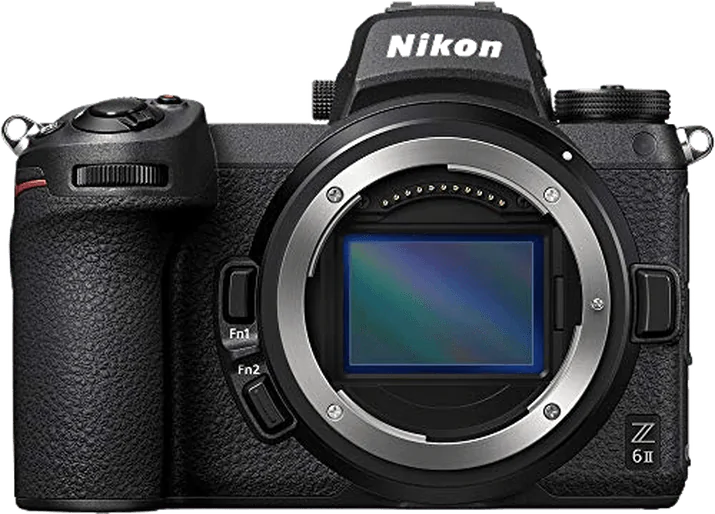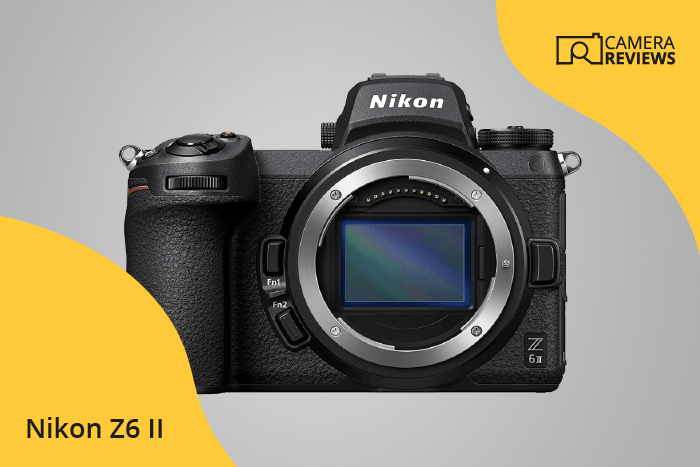Nikon Z6 II Specs and Scores

The Nikon Z6 II earns a solid 83/100 score for its general specifications. Announced on October 14, 2020, and released the same year, this mirrorless camera comes at a launch price of $1995. With dimensions of 134 x 101 x 70mm and a weight of 705g (1.55lbs), the Nikon Z6 II presents a compact and lightweight option for photographers.
In today’s market, the Nikon Z6 II holds its own with its competitive specifications, offering users a high-quality camera experience at a reasonable price. This camera proves to be a strong contender for those looking to invest in a reliable and efficient camera.
Nikon Z6 II Overview and Optics
The Nikon Z6 II receives an optics score of 83 out of 100. With 24.5 megapixels and a shooting speed of 14 frames per second, this camera offers impressive image quality and performance. The full-frame CMOS sensor, combined with a dual Expeed 6 processor, contributes to a DXOMARK score of 94 for the sensor. This high score reflects the camera’s excellent image quality and low-light performance.
Equipped with a Nikon Z lens mount, the Z6 II allows for a wide range of compatible lenses, further enhancing its versatility. The camera also features built-in image stabilisation, ensuring sharp images even in challenging conditions. A 3:2 aspect ratio is standard for the Z6 II, offering a familiar and pleasing image composition.
Given its specifications and performance, the Nikon Z6 II is a strong contender in today’s competitive camera market. Its combination of high-quality optics, versatile lens compatibility, and advanced features make it an excellent choice for photographers seeking both quality and reliability.
Nikon Z6 II Video Performance
The Nikon Z6 II has a video score of 91 out of 100. This camera offers a maximum video resolution of 4K and dimensions of 3840 x 2160, ensuring sharp and detailed footage. The camera also supports a maximum video frame rate of 120fps, allowing for smooth slow-motion capture.
In comparison to other cameras on the market, the Nikon Z6 II stands out with its combination of high-quality resolution and fast frame rates. The built-in time-lapse functionality further enhances its video capabilities, making it a versatile choice for those looking to create dynamic content.
The Nikon Z6 II’s video features make it a strong contender in today’s market, providing users with the tools needed to create impressive video content. Its performance in this area justifies its high video score of 91.
Nikon Z6 II Features and Benefits
The Nikon Z6 II receives a feature score of 87 out of 100. This score highlights the camera’s impressive mix of specifications, making it a strong competitor in the market. The Z6 II boasts a 3.2-inch screen with a resolution of 2,100,000 dots, ensuring crisp and clear image previews. The touchscreen functionality further enhances the user experience.
While the camera does not have a flip screen, it compensates with integrated WiFi and Bluetooth capabilities, allowing for seamless connectivity and file sharing. However, the lack of GPS may be a drawback for some users seeking location-based data.
Considering these specifications, the Nikon Z6 II proves to be a powerful camera suitable for various photography needs. Its feature-rich design and strong performance make it a worthy investment for both amateurs and professionals alike.
Nikon Z6 II Storage and Battery
The storage and battery of the Nikon Z6 II earn a score of 71 out of 100. This camera has two memory card slots, which accept SD, CFexpress Type B/XQD (UHS-II compatible) cards, providing versatility in storage options. In today’s market, it is essential for cameras to have dual card slots, and the Nikon Z6 II meets this requirement.
The battery life of the Nikon Z6 II allows for 410 shots per charge, using an EN-EL15c battery type. While this battery life is not the highest in the market, it is sufficient for most photography sessions. Additionally, the camera supports USB charging, providing convenience for users on the go.
In terms of storage and battery, the Nikon Z6 II offers a competitive package, with dual card slots and USB charging capabilities. Although its battery life is not the longest, it remains adequate for most users.
Nikon Z6 II Alternatives
Do you want to know how the Nikon Z6 II compares to its competitors? Have a look at the most popular comparisons for this camera below:
- Nikon Z6 vs Z6 II
- Nikon Z5 vs Z6 II
- Nikon D850 vs Z6 II
- Nikon Z6 II vs Sony a7 IV
- Nikon Z6 II vs Z7 II
- Nikon Z6 II vs Sony a7 III
Nikon Z6 II FAQ
Does the Nikon Z6 II Have Built-in Image Stabilization?
Yes, the Nikon Z6 II features a 5-axis in-body image stabilization system, which helps to reduce camera shake and produce sharper images, especially in low light situations.
Does the Nikon Z6 II Support 4K Video Recording?
Yes, the Nikon Z6 II supports 4K video recording at up to 60 frames per second, providing high-resolution and smooth video footage for professional and creative videography.
What Size Sensor Does The Nikon Z6 II Have?
The Nikon Z6 II is equipped with a full-frame 24.5-megapixel CMOS sensor, which enables excellent image quality, dynamic range, and low-light performance.
Does the Nikon Z6 II Have a Dual Memory Card Slot?
Yes, the Nikon Z6 II features a dual memory card slot, supporting both XQD/CFexpress and SD UHS-II memory cards, providing flexibility and redundancy for storing images and videos.
Does the Nikon Z6 II Have a Touch Screen?
Yes, the Nikon Z6 II comes with a 3.2-inch tilting touch screen, making it easy to navigate menus, review images, and control focus points for both photography and video recording.
Does the Nikon Z6 II Have Wi-Fi and Bluetooth?
Yes, the Nikon Z6 II has built-in Wi-Fi and Bluetooth connectivity, allowing for easy image transfer, remote control, and seamless integration with the Nikon SnapBridge app on smartphones and tablets.
Does the Nikon Z6 II Have GPS?
No, the Nikon Z6 II does not have a built-in GPS module. However, you can use the Bluetooth connection with your smartphone to geotag your images using the Nikon SnapBridge app.
Is the Nikon Z6 II Weather Sealed?
Yes, the Nikon Z6 II features a robust weather-sealed construction, making it resistant to dust, moisture, and harsh environments, ensuring durability and reliability for outdoor photography.
Does the Nikon Z6 II Have a Built-in Flash?
No, the Nikon Z6 II does not have a built-in flash. However, it is compatible with a range of external flash units through its hot shoe mount for additional lighting options.

